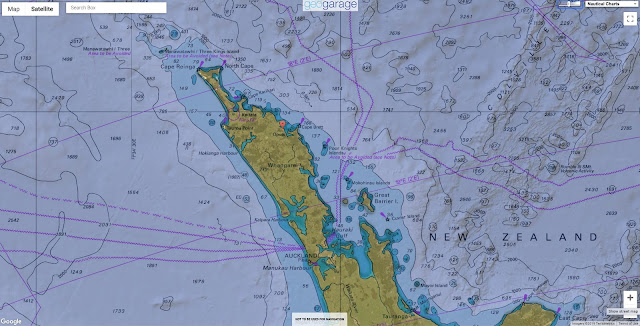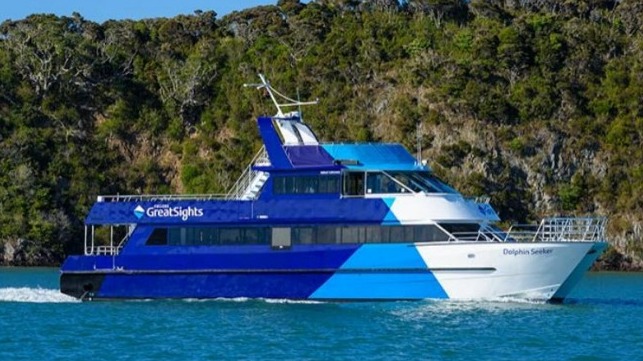Photo / supplied Northern Advocate
From The Maritime ExecutiveNew Zealand's Transport Accident Investigation Commission has released its report into the grounding of the Dolphin Seeker in October 2018 noting the skipper was effectively working alone in a high-risk situation and not making adequate use of electronic navigation aids.
Excerpt of chart of the Bay of Islands showing the afternoon voyage of the Dolphin Seeker
The restricted-limits passenger catamaran Dolphin Seeker was on her second dolphin-watching tourist trip of the day in the Bay of Islands, with six crew and 47 passengers on board.
The skipper had located a pod of dolphins near the Brampton Bank area and was maneuvering the Dolphin Seeker to stay with the pod, at the same time as giving a commentary over the public address system, when the vessel ran aground on rocks at slow speed.
Nobody was injured, but the vessel sustained significant damage to both propellers and minor damage to its hull.
The passengers were transferred to another company vessel.
The Dolphin Seeker was re-floated on the rising tide and towed back to her berth.
The Commission found that the grounding occurred because the skipper did not notice that the vessel had moved into shallow waters while focusing on giving a passenger commentary at the same time as maneuvering the vessel to maintain proximity to the pod of dolphins.
The Commission also found that the skipper was effectively working alone in a high-risk situation.
There were few or no defenses in place to prevent the one-person errors that resulted in the
grounding, such as fully utilizing the features of the vessel’s electronic navigation equipment.
The report states that the skipper was competent in using the electronic navigation aids on the Dolphin Seeker, and they were switched on and available for immediate use.
However, the skipper did not routinely use them to full effect and neither did some of the operator’s other skippers.
The Dolphin Seeker
One reason for this was that most operations were tourism based and only occurred in good weather.
The skippers were fully familiar with the Bay of Islands area, and they usually navigated visually.
“A key component of using electronic navigation aids effectively is that the users must be fully current and practiced in their use so that they can seamlessly switch back and forth between visual and electronic navigation.
That ability depends on their routine and frequent use of the equipment, and the equipment being set up for the conditions at the time,” states the report.
There were at least two available features of electronic navigation equipment that could have been used to improve navigation safety, and either would likely have prevented this grounding:
- the chart plotter could have been used to effectively geo-fence hazards such as the rocks. Due to the repetitive nature of the Dolphin Seeker’s mission, and the common equipment across the fleet, it would be achievable to geo-fence most navigational hazards within the Bay of Islands
- the depth sounder could have had an alarm set to alert the skipper when the vessel moved into shallow water.
In one case the electronic navigation aids were not configured correctly for immediate use.
In both cases the alarms were either not set or silenced, or were noticed by the crew and not acted on.
Links :
/arc-anglerfish-syd-prod-nzme.s3.amazonaws.com/public/KWBWAVGQQBH3VLHVPM7CR5MN3M.jpg)




No comments:
Post a Comment